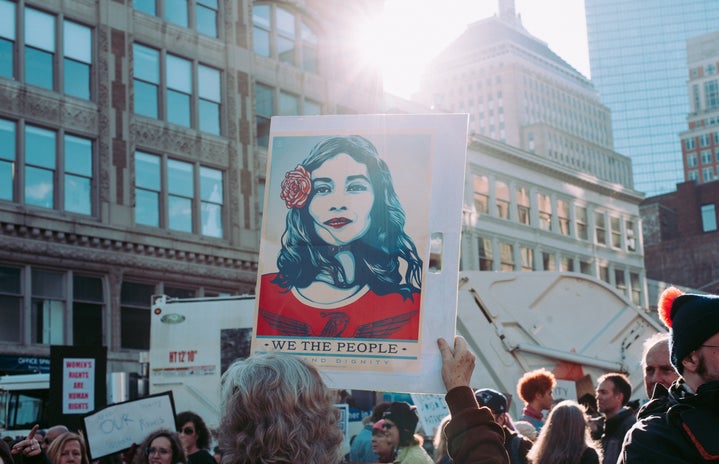All it takes is one hit to get hooked.
You never plan it.
No one plans to get addicted.
It just happens.
You can’t help it. You feel like you’ve got it under control.
You feel like, if you wanted to, you could quit.
But you know deep down that you’re the one being controlled.
You’re traipsing through life on puppet strings.
Taking all the hits the world throws at you.
Justifying them with hits you take through your veins, or into your lungs.
I understand addiction through the lens of books, which I was (in a sense) addicted to while growing up. It’s an escape. It’s a way to leave behind this world and our problems and focus on something else for a change. Books gave me the opportunity to laugh, to cry, to explore hidden cities and reflect on real-life problems.
Substances do pretty much the same thing in a different sense. It’s an escape. It lessens pain, heightens happiness.
Books were my addiction growing up – my library card, my dealer. Though they can break your heart, they don’t have the ability to kill.
Opioids like morphine, codeine, fentanyl, oxycodone, hydromorphone, heroin, and countless others, do.
Nevertheless, comparing a reading addiction to drug addiction is like comparing a candle’s flickering flame to a raging forest fire.
The opioid crisis in Ontario is very real and very troubling – more so by the reality that it is often overlooked.
If you had someone in your family or friend circle who had a substance addiction, you would be worried about them—about where they sleep, how the drugs are affecting them, and the possibility of death.
Not all substance users are crouched in dark alleys, shooting needles into their arms. In fact, that’s what we see on TV. In reality, anyone can have a problem—from your professor to that 14-year-old high schooler who mows your lawn in the summer.
Imagine you know someone named, for instance, Robbie. He used to go to University. He was in the second year. He had a mom, and dad, and a younger brother named Jack. Imagine he had a tiny puppy named Fox. He lived with his family in a comfortable cul de sac. On the weekends, Robbie worked at a bookstore, making $14 an hour. He was saving up to add an upgrade to his 2003 Toyota. His parents had gifted him that car on his 17th birthday and he’d refurbished the interior and repainted the outside of it. It was his prized possession.
Imagine that Robbie now, at 20 years old, lives in that 2003 Toyota. It’s not the shiny gem from 2 years ago. The exterior of the car is scratched up and dusty, the interior littered with take-out trash, the plush seats painted with stains of various colours. The money he’d saved for an upgrade went into his veins instead.
His parents haven’t seen him in two years. His brother Jack misses him dearly but understands there’s something strange going on. He thinks he saw Robbie standing by the Ambassador bridge as they drove by a few weeks ago, though he can’t really be sure it was him. After all, Robbie’s hair was always neat and short. He always had a smile on his face. The man under the bridge looked sad and lonely.
His family and friends would never know this, but on weekdays, Robbie sat by the Goodwill store with a white styrofoam cup in his hand, his cap pulled low to cover his eyes. No matter how long he sat there, he always felt humiliated waiting for hours on end and collecting a few coins. Most nights he made enough. Other nights, he had to find other ways to make ends meet.
Sometimes he thought about quitting. It was always a brief thought—the hopelessness that accompanied it was overwhelming at the best of times. He kept his family out of his mind, though sometimes a memory would flood his thoughts and he would be reduced to tears. He tried to keep his emotions as dull as possible—he had become reckless and he didn’t want to do something he would regret.
Life was on a day-to-day basis for Robbie.
Happiness was at the end of a bottle. Oblivion was in a syringe. For two years straight, that was all he’d ever known. Nothing else mattered.
He was not the Robbie of the past, there was no questioning that—he didn’t care about his Ecology degree anymore, and his car was just an object.
Some things hadn’t changed though—he still loved to draw. He’d sketch wherever he had the opportunity—on a napkin with the stub of pencil he kept in his pocket, on the sidewalk with a piece of chalk he spotted beside a curb. He drew whatever came to mind, and sometimes people dropped a coin into his cup as they walked by.
He often imagined his parents and Jack stumbling on his drawings. Would they stop and stare? Would they wonder for a second if his hand had created that? His puppy would bark, and his family would want to believe he had been there, but they would turn away, brushing away the tears as they walked onwards.
Did they hate him, he often wondered, on the rare occasion he let his thoughts run free. He knew they didn’t hate him, but surely they felt some sort of way. The guilt from that was the fuel that had him running for oblivion. He couldn’t stand to feel so utterly powerless.
One night, he stumbled across his family. They didn’t recognize him, but he certainly recognized them. His parents looked the same as ever, with a few additional wrinkles. Jack was a head taller—he was what, eleven now? His heart stopped and he had the urge to turn away and cover his face, but there was no need—his family walked past him without even noticing him.
The devastation that followed was horrible. The relief of not having to meet his family overshadowed by the horror of having been forgotten.
That night in his car, with angry tears streaming down his face, Robbie’s fingers trembled as he got his supplies. Through tearful eyes, he miscalculated—he took into his spoon more than he was used to. But he wasn’t thinking about that—he just wanted to stop his thoughts, to stop the pain of thinking.
He also wanted to quit his habit, wanted to change for the better—but help was so far away and his situation so hopeless.
Within a couple of minutes, relief washed over him like a wave, lulling him to sleep. But the drug wasn’t done. And as he fell into peaceful, pain-free oblivion, his heart rate increased and rose incredibly high. Higher and higher, faster and faster it went, and his breath became hitched until finally, his breathing stopped altogether.
If only something had been there to stop him. If only something had prevented that extra substance from taking his life.
Now imagine this: Robbie had known about safe injection sites—a place to get safe tools, someone observing to make sure he was safe. He would have walked in habitually, perhaps crying. Not only would he have had someone to help him with his injection without any judgment, but he’d have a person to speak to if he wanted to. Being around other people changes one’s emotions and Robbie might have either bottled up his vulnerability for another time, or he may have opened up finally. Help would have been nearby if something were to go wrong. A shot of naloxone would have been all that was needed to save his life.
Supervised Consumption Services (SCS) include supervised injection services (SIS), overdose prevention services (OPS) and consumption treatment services (CTS). The following services are provided under this umbrella term:
-
Supervised consumption
-
Overdose prevention
-
Onsite or defined pathways to addiction treatment services
-
Onsite or defined pathways to wrap-around services including;
-
Primary care
-
Mental health
-
Housing and/or other social supports
-
The provision of naloxone and oxygen.
-
And additional harm reduction services such as education, distribution, and disposal of harm reduction supplies.
-
Unfortunately, due to the lack of ability of these services, Robbie was alone in his car—the only place he felt he could go.
And this is how it would have played out anyway.
Because Windsor doesn’t have any safe injection sites.
The crisis is at an all-time high in Ontario and the Windsor Overdose Prevention Society’s goal is to have safe injection sites (SIS), but they are opposed by Mayor Drew Dilknes and police officials who object the idea of aiding people in using illegal drugs.
The idea behind the opposition is that safe injection sites support criminal behaviour. Substances like Meth and cocaine should remain illegal regardless of where they are being consumed. Al Frederick, Windsor’s former Chief of Police stated on CTV Windsor that “we just can’t ignore the fact that, outside of […] safe injection [sites], it’s illegal to possess [those substances]” (Veneza, 2018).
Although that argument is true, Frederick fails to see that the point of SIS is to save lives.
51 people died last year due to overdose, and 22 people have died in the first three months of 2019. “Double the number from the same period in 2018,” (Garton, 2019). That is too many lives lost.
The Registered Nurses Association of Ontario (RNAO) does an impeccable job outlining the severity of this issue. Here are some stats summarised from the RNAO Fact Sheet on Accidental opioid overdoses: decide for yourself if this is a crisis or not?
-
4 Ontarians die each day from opioid overdose
-
867 overdose deaths in Ontario in 2016 vs. 1,473 deaths in 2018
-
12,000 Canadians died from an accidental opioid overdose from 2016 – 2018
The RNAO has been on top of this crisis since 2011 when the case against Insite in Vancouver appeared in the Supreme Court of Canada. The RNAO argued for keeping Vancouver’s SIS open. In 2013, the RNAO urged Ontario to improve and increase the response to the opioid crisis by introducing more SIS/OPS in locations where they were deemed necessary. 2018 saw RNAO publish a Best Practice Guideline (BPG) titled ‘Implementing supervised injection services.” In 2019, the struggle remains and the RNAO is advocating to make services accessible to those who use drugs and could benefit from such services. The opposition comes in the form of the government putting a cap on the number of sites allowed, that being 21, along with a very convoluted, lengthy application process.
On November 1, 2019, an alert was issued when emergency rooms saw 11 overdose visits. Of the 11, five were opioid-related overdoses. Another alert was issued a few days later due to a spike in cases on November 5th (Borrelli, 2019).
In this time frame, Naloxone was administered by EMS in seven cases. Naloxone is an opioid-antagonist – meaning that it prevents opioids from connecting with the receptors in the body, temporarily inhibiting the effects of the opioid. There are no adverse effects of using Naloxone. According to the Ontario Provincial Police, since officers began carrying naloxone in September 2017, 102 lives have been saved (CBC, 2019).
Despite this, Windsor police do not carry naloxone.
Police chief Pam Mizuno, the first female to be appointed, told CBC that she would not be “revising her predecessor’s policy on naloxone kits,” (CBC, 2019).
What you can do right now: take action by visiting the RNAO’s Policy and Political action page to Demand an end to overdose deaths in Windsor. Here you can urge Chief Mizuno to make sure her workforce carries and are trained to use naloxone kits and to demand CTS sites for Windsor.
Doris Grinspun, CEO of the RNAO, told CBC News earlier this month that this situation is shameful. “Everyone is ready to move forward. We need now the mayor [and] the police chief to take leadership,” (CBC, 2019).
References:
Borrelli, M. (2019). Another alert issued over opioid-related ER visits. CTV News Windsor.
Retrieved from https://windsor.ctvnews.ca/another-alert-issued-over-opioid-related-er-visits-1.4674179
CBC News. (2019). Lasalle police officers haven’t used naloxone once since kits became mandatory in 2017. CBC News.
Retrieved from https://www.cbc.ca/news/canada/windsor/lasalle-police-haven-t-used-naloxone-once-1.5351016
CBC News. (2019). Nursing leader says ‘shame’ on Windsor police, mayor for ignoring opioid problems. CBC News. Retrieved from https://www.cbc.ca/news/canada/windsor/nurses-windsor-rnao-opioid-1.5356621
Garton, R. (2019). Nursing chief to Windsor police chief: allow naloxone and safe consumption sites. CTV News Windsor. Retrieved from https://windsor.ctvnews.ca/nursing-chief-to-windsor-police-chief-allow-naloxone-and-safe-consumption-sites-1.4680911
RNAO Fact sheet: Accidental opioid overdoses: A public health crisis. (2019). RNAO. Retrieved
from https://qpor.rnao.ca/sites/default/files/Accidental%20opioid%20overdoses%20fact%20sheet%202019.pdf
RNAO Queen’s Park on the Road: Accidental Opioid Overdoses: A public health crisis. (2019). RNAO.
Retrieved from https://qpor.rnao.ca/sites/default/files/Accidental%20opioid%20overdoses%20bulletin% 02019_FINAL.pdf
Vaneza, R. (2018). Proposed safe injection site probing controversial. IHeartRADIO. Retrieved
From https://www.iheartradio.ca/am800/news/proposed-safe-injection-site-proving-controversial-1.3820344



